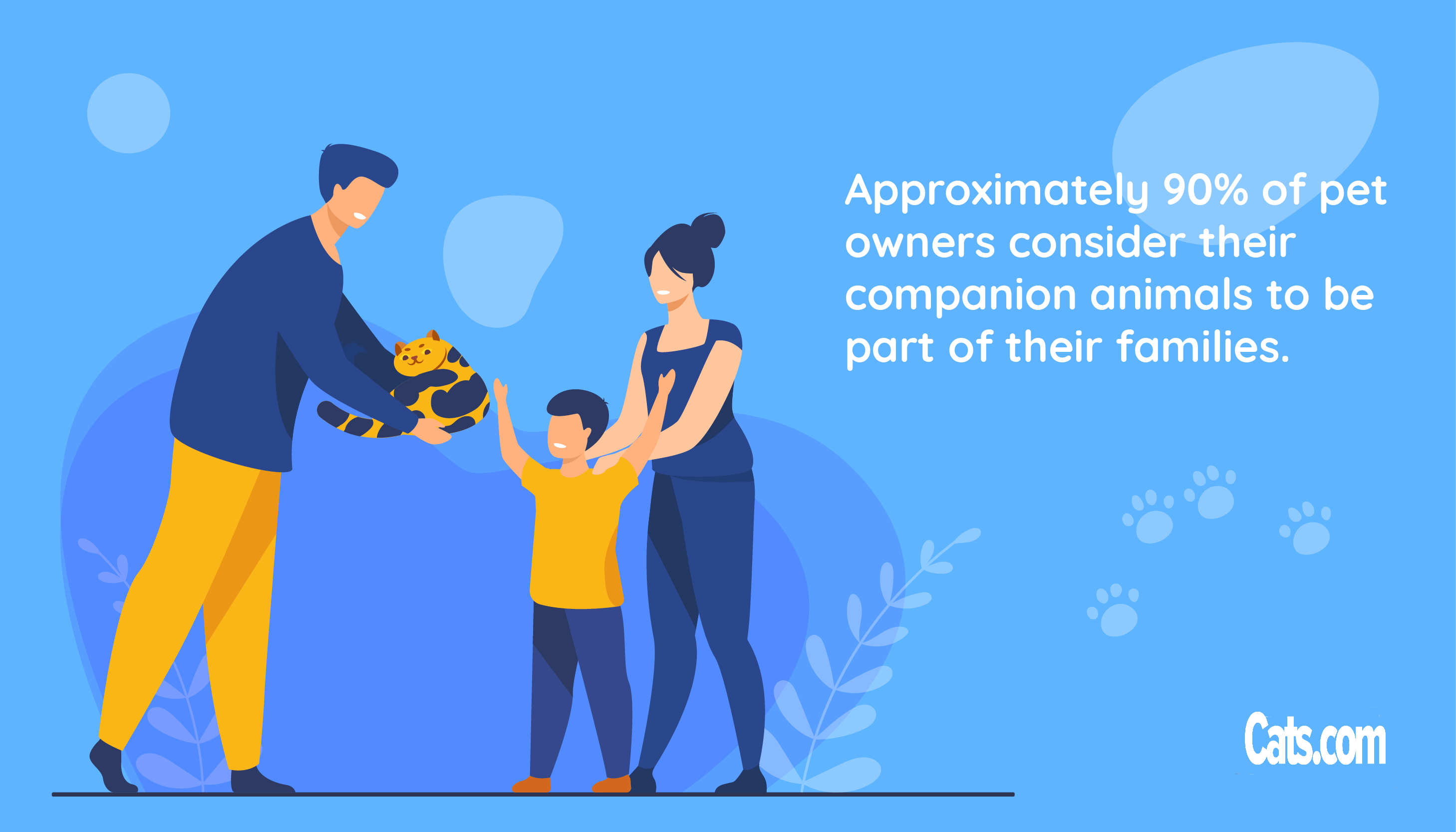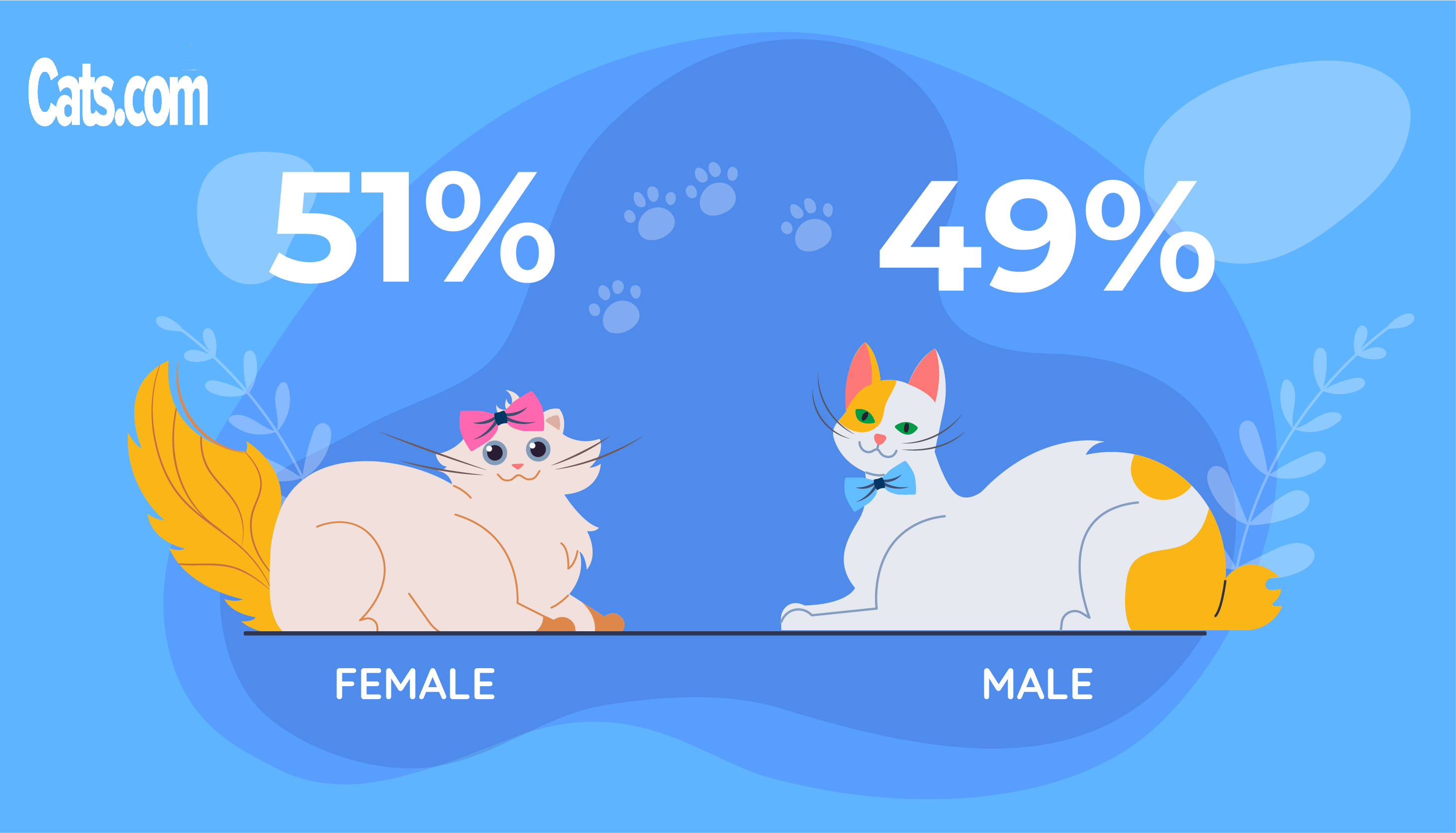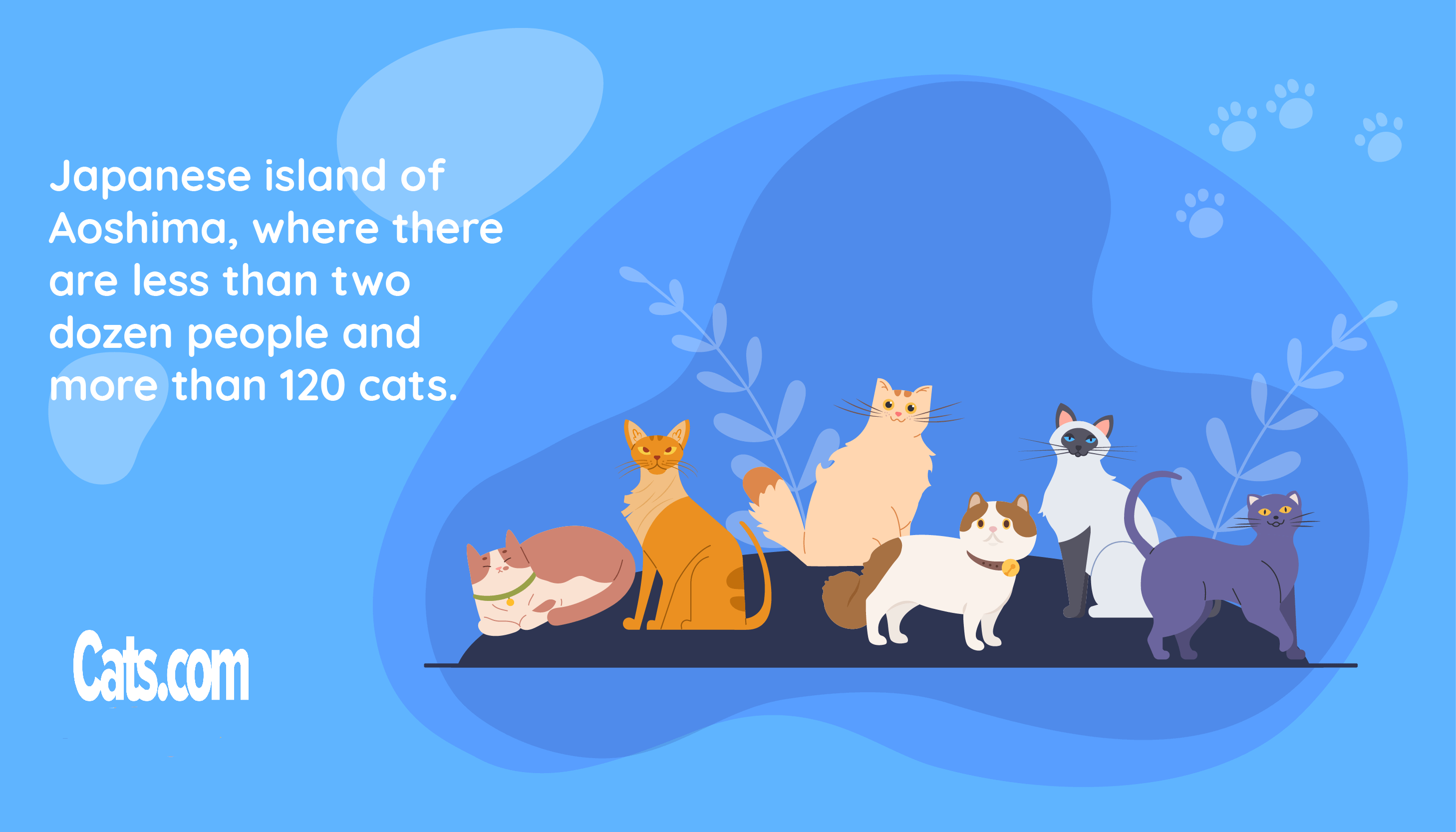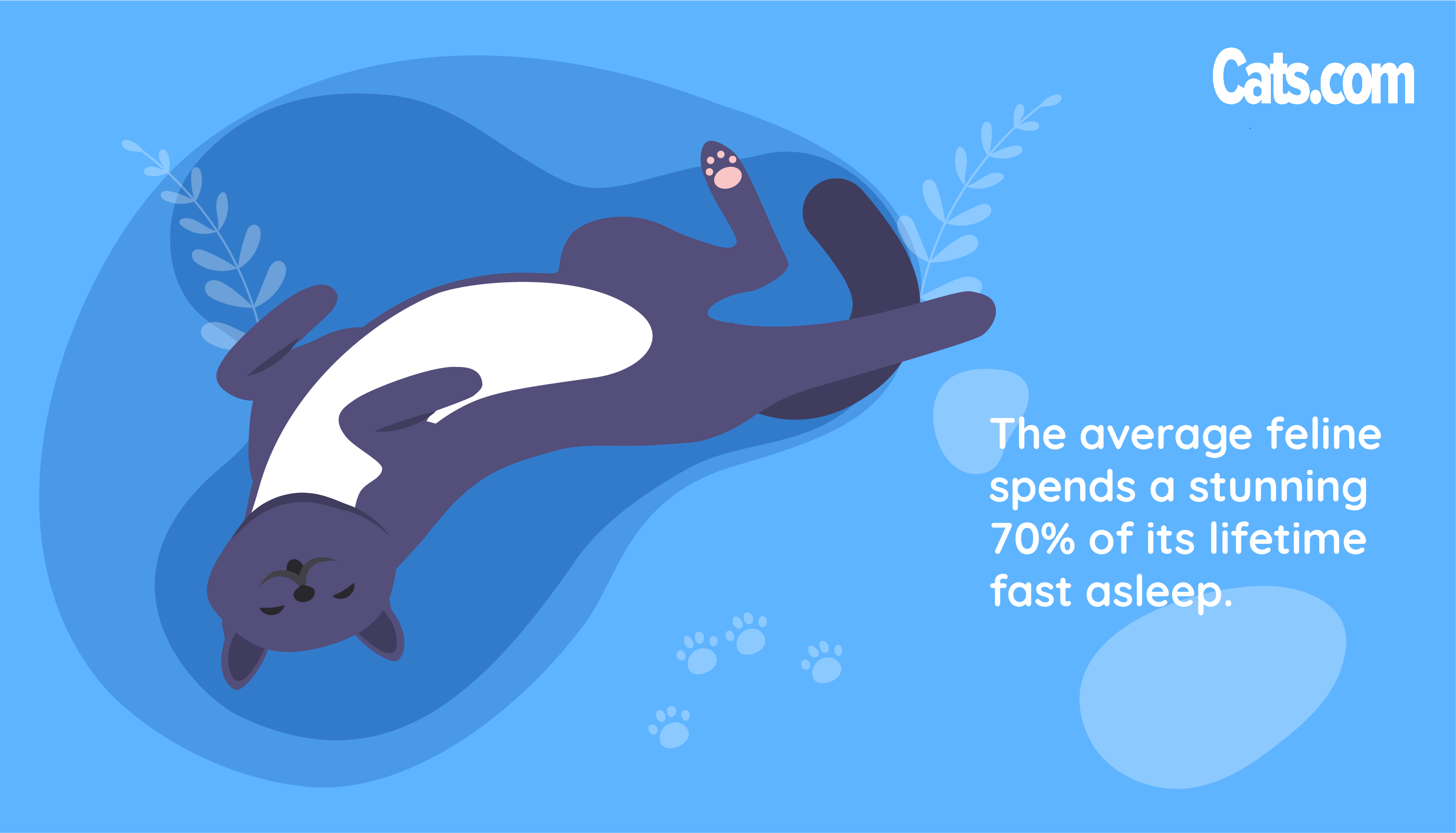Ready for some fun? We’ve curated a massive list of cat statistics and feline facts to fuel your thirst for knowledge about all things cat!
So grab your favorite drink and convince your kitty to read along. By the time you reach the end, you’ll know even more about cats!

Adoption
According to the ASPCA, a shocking 6.5 million pets find their way into American animal shelters every year. Approximately half of those – 3.2 million – are cats.
Although the number of shelter pets euthanized each year has dropped sharply, approximately 1.5 million animals never find their way into permanent homes and are put to sleep. Of those, approximately 860,000 are cats.
An increase in adoptions – and an increase in no-kill shelters and private cat rescues – are partly to thank for the current reduction in the number of euthanized pets. Approximately 3.2 million shelter animals make their way into adoptive homes each year. Of those, approximately 1.6 million are cats.
Breed
Since this is a word with two meanings and both apply to cats, we will offer two cat statistics.
First, let’s talk cat breeds. Right now, the Ragdoll is the world’s most popular cat breed. These adorable felines are noted for their silky soft coats, their enormous blue eyes, and their wonderfully laid-back dispositions. Ragdoll cats were developed during the 1960s, and have been gaining popularity ever since then.
Runners-up include the Exotic, the British Shorthair, the Persian, and the Maine Coon Cat.
Next, let’s take a look at a couple of breeding statistics. Despite efforts at encouraging pet owners to have their animals spayed and neutered, nearly 70,000 puppies and kittens are born every day in the United States. Of these, only one in 12 cats manages to find a happy forever home. Since dogs matter, too, you might be interested to discover that only one in 10 puppies is successfully adopted by a loving family.
Cost
The cost of owning a cat is lower than the average cost of dog ownership, but typically comes in higher than owning birds or fish. The most expensive pets to own? Horses for the win!
Death
The average cat’s lifespan can be anywhere from 2 to 16 years. As can’t statistics go, this one isn’t very precise – but the reason for it is that there are two very different groups of cats. Each group of cats has a distinctly different outcome.
As you might have guessed, beloved pets have a far higher life expectancy then strays and feral cats. Thanks to veterinary care, appropriate vaccinations, and lives that play out mainly indoors, cats with homes live for an average of 16 years.
Feral cats and strays can count themselves fortunate to live beyond two years of age. The most prominent cause of death in cats might surprise you: it’s euthanasia. And it isn’t euthanasia at the end of a long life well-lived in the arms of a comfortable family home.
Most cats meet their fate in shelters, where they are euthanized when time runs out or when they arrive badly injured or too sick to be adopted.
We all can do our part to reduce this sad cat statistic by seeing to it that our pets are spayed and neutered. Simply reducing the number of unwanted kittens can help reduce the number of cats euthanized in shelters each year.
Euthanasia
It’s a subject we are sorry to address – but one that’s far too important to ignore. Euthanasia offers a humane end to an animal’s life when no other option exists.
We offered some insights into euthanasia in previous entries. Now for a little bit of good news: in 2011, approximately 2.6 million shelter pets were euthanized out of necessity. By 2019 the number had dropped by about 1 million. We hope to see a steady decline as more shelter pets are adopted and more stray cats and dogs find their way home to their families. Even more impressive is the fact that euthanasia rates in US shelters are now 75% lower than they were in 2009.
Here’s one more cat statistic that might alarm you: If you are thinking about adopting a cat or another pet from a shelter, consider choosing a black one. Most black pets that find their way to shelters are euthanized simply because they aren’t selected for adoption as frequently as pets with lighter-colored coats.
Family
Do you think of your pet as part of the family? If so, you’re in good company. A survey published in Scientific American Mind noted that even snake owners consider their pets to be part of the family. Overall, approximately 90% of pet owners consider their companion animals to be part of their families.

Gender / Genetics
Here’s a fascinating cat statistic that has to do with both gender and genetics: approximately 51% of American cats are female and 49% are male. When it comes to genetics, coat colors, and eye colors, something fascinating happens among 100% of domesticated cats. All kittens are born with blue eyes, regardless of breed and final eye color.
100% of cats begin life as tabbies, too. A kitten’s color, coat pattern, and hair length are determined before birth, but not until later in development. Many solid colored kittens still show a tabby pattern beneath their coats.
The tabby pattern doesn’t go away with age – it is simply disguised by the fuller, longer coats that an adult cat develops. If you have a solid colored cat and you look at them when they’re lying in bright sunlight, you can probably make out a very faint tabby pattern beneath that beautiful solid-colored coat.
Fun fact: All cat colors are some combination of black, white, and red – which is more commonly referred to as orange, as in orange tabby. Of course, there are different shades of all these colors as well as different dilutions and blends.
In all, there are hundreds of different can’t colors and coat patterns because the genes and polygenes are so varied.

Healthcare
We are doing better than ever when it comes to looking after our pets’ health. In 2020 alone, an estimated $16.62 billion will be spent on veterinary care. Pet parents will spend even more on over-the-counter medication for their furred, finned, and feathered family members.
On average, cat owners spend a little bit less at the vet than dog owners do. The average surgical vet visit for a cat costs $245, while a surgical vet visit for a dog comes in at $474. The average emergency vet visit costs a cat owner $154 while a dog owner can expect an average bill of about $349.
Routine vet visits cost cat owners an average of $182 per year. Meanwhile, dog owners can expect to pay $257 for a year’s worth of routine canine veterinary expenses. Parasite control costs cat owners less, as well. The average cost for cat heartworm medication is $65 per year. Dog heartworm medication averages $102 per year. Flea and tick control prices are closer to one another: Keeping a cat free from biting bugs costs an average of $77 per year. Dog owners spend a little bit more – about $85 per year.
Insurance
More pet parents are purchasing pet health insurance to cover veterinary costs. In 2017, the North American Pet Health Insurance Association reported $1.15 billion in pet insurance sales. By the end of 2018, that figure had jumped to $1.42 billion.
We can expect the pet insurance market to reach an astonishing $11.25 billion by the year 2026. The increase is being driven by higher numbers of pet adoptions as well as more flexibility in the veterinary and pet insurance marketplaces combined.
Japan
Have you ever heard of Cat Island? This is a nickname for the Japanese island of Aoshima, where there are less than two dozen people and more than 120 cats. This is just one example that illustrates how popular cats are in Japan. In all, Japan is home to approximately 7.25 million cats.

Kitten Season
Kitten season happens when the weather warms up and more cats get together to breed. Cats can have kittens anytime of the year, but most leaders are born during the warmer months.
According to the North Shore Animal League, tens of thousands of puppies and kittens are born on a daily basis. In contrast with those 70,000 tiny animals, just about 10,000 people are born each day in the US.
Litter
The average cat has 4 to 6 kittens per litter. This number is tiny in comparison to the world’s largest known litter of domestic kittens: they were born in 1970 when a cat in the UK gave birth to 19 kittens. 15 of them were born alive.
Mental Health
If you believe that your cat is good for your well-being, you are definitely in good company! A survey of pet owners found that 74% of people felt that having a pet as part of the family improves their mental health. The same survey found that 75% of respondents were confident that pets belonging to friends and family members improve the mental health of others, too.
Cat Nap
Most of us are lucky to catch a full night’s sleep a few times per week. Imagine being a cat: The average feline spends a stunning 70% of its lifetime fast asleep.

Ownership
People and pets have coexisted for millennia. Right now, we’re experiencing a boom! In America, pet ownership has increased by a whopping 300%. About 67% of all households in the United States have pets. Of all households throughout the US, 35% have cats. Dogs have a slight edge, occupying 44% of all American households.
Partner
Here’s yet another fun cat statistic – and it’s one that might just surprise you! Single guys, pay attention: a full 90% of single women surveyed felt that men who had cats were nicer than men who didn’t have cats. We are suggesting that you get a cat as a means to find a partner, but if you have one, you might want to list it on your dating profile.
Once you’ve made the connection, you might prefer your pet over your partner at times. About 44% of people surveyed said that they would rather curl up with their pet then their human companion.
About 50% of participants in the same study said that they preferred to spend their time with their cats and dogs over their life partners. That’s not all: Three of every ten pet owners surveyed said their pet was a better listener than their significant other!
Queen
This isn’t exactly a cat statistic but it is an answer to a commonly asked question! Here goes: What is a female cat called?
If you guessed Princess, you’re close! Female cats are called queens. It’s a fitting name, don’t you think?
Rodents
Humans and cats have shared a bond throughout history. In America, the idea of keeping cats as pets began in the 19th century. Before that, cats were considered to be something closer to employees, tasked with the very important job of keeping the rodent population down.
Cats continue to hunt rodents and other small animals whenever they have the opportunity. In fact, they are the number one predator of birds and small animals.
Biologists estimate that cats kill 20.7 billion small animals and up to 3.7 billion birds per year. Unfortunately, outdoor cats are directly linked to the decline of songbirds throughout the United States. It’s one more reason to keep your cat indoors whenever possible.

Strays
There are no exact figures, but data from the ASPCA suggests that there are about 70 million stray pets in America – with the number of stray cats equaling or perhaps exceeding the number of cats with permanent homes.
Some stray cats are adopted off the street. About 27% of cats find homes with people who acquire them as strays. This number is down from 2012, when cat owners reported adopting 35% of their pets after finding them wandering the streets.
Dogs don’t fare as well as cats when it comes to being adopted as a stray. Only 6% of dogs are acquired as strays.
We all can help reduce the number of unwanted pets and stray animals wandering. Spaying and neutering our pets has a direct impact on the number of unwanted animals. We can encourage friends and loved ones to spay and neuter their pets, as well.
Therapy Pets
When we think of therapy pets, dogs often come to mind. These days, cats are playing important roles as therapy pets, too. The number of results for emotional support cats in a Google search stands around 2.4 million. In comparison, there are about 5 million Google search results for emotional support dogs.
The number of emotional support cats is increasing, thanks to their ability to help people heal while reducing anxiety, depression, and loneliness.
The vibration from a cat’s purr offers a therapeutic effect and helps people relax. Studies show that being around cats can reduce blood pressure, produces a sense of calm, and even help prevent and treat chronic conditions. Studies suggest that having a cat can strengthen your immune system and perhaps even lengthen your life.
Therapy cats and dogs find their way into roles helping autistic children gain greater confidence in the world, and they are of particular value to elderly dementia and Alzheimer’s disease patients.
USA
Approximately 90.5 million American families have pets. The nation is home to the largest dog and cat population worldwide, with about 70 million dogs and approximately 74 million cats.
In comparison, China is home to over 27 million dogs and 53 million cats while Russia has a dog population of over 12.5 million and a cat population of about 17.8 million.
Vocabulary
When it comes to vocalizations, cats have dogs beat! Dogs have a vocabulary that contains 10 different vocalizations. In comparison, cats are capable of making about 100 different vocalizations. There’s more: every cat has a unique vocabulary of its own, consisting of different behaviors and vocalizations, which are reserved mostly for human family members.
Water
Like a human’s body, a cat’s body is made up of mostly water – about 75%. In case you’re curious about how long the average cat might be able to survive without water, it’s approximately three days.
However, there are some variables. Food source, environment, and overall health play important roles and how long a cat can go without water: When cats are able to obtain water from their food, they may be able to survive for a longer period of time. A cat obtaining water solely from food might be able to survive for four days.
Related: Why Is My Cat Drinking a Lot of Water?
Xen
However you spell it, it can help to find your Zen. This might not be a cat statistic but it is a fun fact: Our cats can help us achieve mindfulness. That’s not all. The vibrations that occur while a cat is purring range from 20 Hz to 150 Hz. Vibrations in this range correspond with healing frequencies that have been established in human therapeutic settings.
For example, bone hardens in response to vibrations at the 25 to 50 Hz range, while skin and soft tissue response to frequencies at about 100 Hz. It is believed that cats developed the ability to purr as a means of avoiding inflammation and overuse injuries, and as a built-in method for keeping their bodies in good repair.
When your cat is purring, it isn’t just good for them – it’s great for you, as well. Petting a cat alleviates stress. Research suggests that this contributes to better health for cat parents, since cat ownership might cut the risk of heart disease and stroke by about one third.
Yawn
Here’s another fun cat statistic: 100% of all cats yawn – but those feline yawns don’t all happen for the same reason.
If you see your cat yawning, it could be because they need to expel built-up carbon dioxide and take in more oxygen. It might be happening as a way to boost alertness, or as a boredom signal. Your cat might also yawn as a way to communicate with you or another pet.
Zoo
There are approximately 5000 to 7000 captive tigers in the United States. You might think most of these big cats live in zoos – but just like us, you guessed incorrectly if this was your first thought. In fact, facilities that are accredited by the Association of Zoos and Aquariums are home to fewer than 400 of these tigers. The remainder are held in traveling zoos, unaccredited roadside zoos, unaccredited breeding facilities, sanctuaries, and private menageries.
It’s true that America’s tiger population is huge but the number of tigers in the US is less than 5% of the world’s tiger population.
One more thing to think about before we sign off: There are only about 3,890 known wild tigers, meaning the number of tigers being kept in captivity far outweighs the number of these majestic felines still roaming the jungles and savannahs. We hope this big cat statistic changes for the better – and soon!
That’s it for now! We hope you enjoyed our big A-Z list of cat statistics and fun feline facts. Be sure to share with your fellow cat lovers and tag us on Facebook – and let us know if there are any fascinating cat facts we should cover next time around!